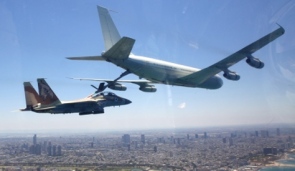NYT: ’’Israel’’ Needs At Least 100 Planes, 1000 Miles Fly to Attack Prepared Iran

Other problem US officials see is penetrating Iran's Natanz facility, which is believed to be buried under 30 feet of concrete, and the Fordo facility, which is built inside a mountain.
Citing the assessment of US War officials close to the Pentagon, the "New York Times" US daily uncovered Monday that ""Israel" will need to use at least 100 planes and fly more than 1,000 miles above unfriendly airspace should it decide to attack Iran."
According to the report, American military analysts and war officials believe that an ""Israeli" strike on Iran's nuclear facilities would be a highly complex operation."

"This would be very different from "Israel's" surgical strike on Iraq's Osirak reactor in 1981 and would also differ from the strike that "Israel" is believed to have carried out in Syria in 2007," the paper clarified.
"
All the pundits who talk about ‘Oh, yeah, bomb Iran,' it ain't going to be that easy," the report quoted Lt. Gen. David A. Deptula, who retired last year as the US Air Force's top intelligence official.
Andrew R. Hoehn, a former Pentagon official, was also quoted as saying, "I don't think you'll find anyone who'll say, ‘Here's how it's going to be done - handful of planes, over an evening, in and out.'"
Meanwhile, the report also cited comments by former CIA director Michael Hayden, who said that ""Israel" is not capable of carrying out airstrikes that would seriously set back Iran's nuclear program", partly due to the distance the aircraft would have to travel.
According to the report, US military analysts believe that "Israel" will have a serious problem reaching Iran's four major nuclear sites: the uranium enrichment facilities at Natanz and Fordo, the heavy water reactor near Arak, and the uranium conversion plant near Isfahan."
""Israel" has three possible routes to those facilities - north over Turkey, south over Saudi Arabia, or a central route across Jordan and Iraq," "NYT" added.
US military analysts believe that "the route over Iraq would be preferable, since Iraq effectively has no air defenses and the US is no longer defending Iraq's airspace."
According to officials, should Jordan allow "Israel" to fly over its territory, the next issue for "Israel" is that the range of its fighter jets falls short of the 2,000-mile round trip.
For this reason, officials say, ""Israel" would need to use airborne refueling planes, called tankers, and then those tankers would need to be protected by more fighter planes, which significantly increases the number of planes needed for the operation."
""Israel" has American-made GBU-28 5,000-pound "bunker buster" bombs that could damage such targets, but it is not known how far down they could go," the report said.
Source: NYT, Edited by moqawama.org
Comments
- Related News

US Senate Votes 15-3 for Arming Syrian Opposition
11 years ago


